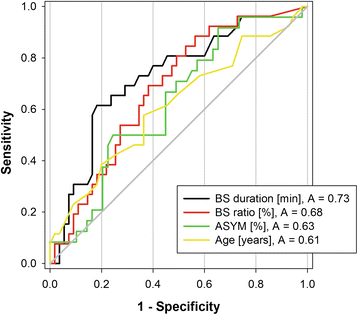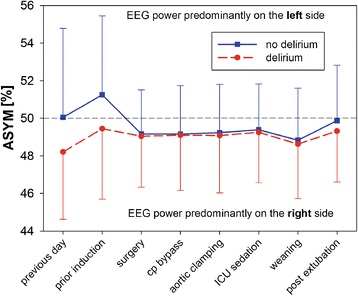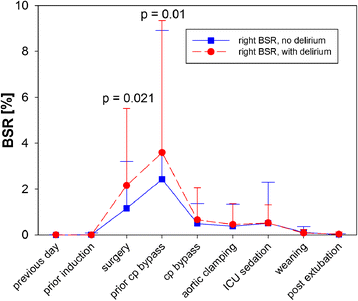Intraoperative burst suppression is associated with postoperative delirium following cardiac surgery: a prospective, observational study
- PMID: 25928189
- PMCID: PMC4419445
- DOI: 10.1186/s12871-015-0051-7
Intraoperative burst suppression is associated with postoperative delirium following cardiac surgery: a prospective, observational study
Abstract
Background: Postoperative delirium (POD) occurs frequently after cardiac surgery and is associated with increased morbidity and mortality. We analysed whether perioperative bilateral BIS monitoring may detect abnormalities before the onset of POD in cardiac surgery patients.
Methods: In a prospective observational study, 81 patients undergoing cardiac surgery were included. Bilateral Bispectral Index (BIS)-monitoring was applied during the pre-, intra- and postoperative period, and BIS, EEG Asymmetry (ASYM), and Burst Suppression Ratio (BSR) were recorded. POD was diagnosed according to the Confusion Assessment Method for the Intensive Care Unit, and patients were divided into a delirium and non-delirium group.
Results: POD was detected in 26 patients (32%). A trend towards a lower ASYM was observed in the delirium group as compared to the non-delirium group on the preoperative day (ASYM = 48.2 ± 3.6% versus 50.0 ± 4.7%, mean ± sd, p = 0.087) as well as before induction of anaesthesia, with oral midazolam anxiolysis (median ASYM = 49.5%, IQR [47.4;51.5] versus 50.6%, IQR [49.1;54.2], p = 0.081). Delirious patients remained significantly (p = 0.018) longer in a burst suppression state intraoperatively (107 minutes, IQR [47;170] versus 44 minutes, IQR [11;120]) than non-delirious patients. Receiver operating analysis revealed burst suppression duration (area under the curve = 0.73, p = 0.001) and BSR (AUC = 0.68, p = 0.009) as predictors of POD.
Conclusions: Intraoperative assessment of BSR may identify patients at risk of POD and should be investigated in further studies. So far it remains unknown whether there is a causal relationship or rather an association between intraoperative burst suppression and the development of POD.
Trial registration: clinicaltrials.gov NCT01048775.
Figures



References
-
- American Psychiatric Association . Diagnostic and Statistical Manual of Mental Disorders - DSM-IV-TR. 4. Washington DC: American Psychiatric Association; 2000.
Publication types
MeSH terms
Associated data
LinkOut - more resources
Full Text Sources
Other Literature Sources
Medical
Miscellaneous

